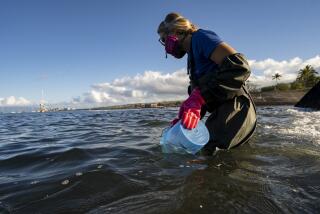Coral Reefs Face Crucial Time
- Share via
Above French Frigate Shoals — The remote 1,400-mile-long string of the northwestern Hawaiian Islands are blanketed with the 14 million seabirds that nest there. Beneath the surface of the surrounding waters, fish crowd into pristine coral reefs.
The islands are home to about 7,000 species of birds, fish and marine mammals, a quarter of which are unique to Hawaii.
Although the islands have been protected for almost a century as a refuge, the surrounding reefs are entering a critical year for their protection.
“This refuge that spans 1,400 miles is America’s Galapagos, and Americans don’t know it,” said James L. Connaughton, chairman of the White House Council on Environmental Quality and a pivotal player in the fate of the reefs.
Over the next year, the National Oceanic and Atmospheric Administration will be developing rules for managing the waters of the island chain under a proposed sanctuary status, which could prohibit or even expand fishing and activities such as coral and lobster harvesting.
Banning fishing in the 132,000-square-mile area would create the second-largest no-take marine sanctuary in the world, behind only the Great Barrier Reef in the northeast of Australia, which prohibits fishing in about one-third of the structure.
There are currently nine fishing operations working the Hawaiian refuge, using weighted, baited fishing lines to catch about $1.5 million worth of snapper and sea bass, state officials say.
Republican Gov. Linda Lingle, who in the fall signed rules banning all fishing from state waters, extending three miles offshore, has pushed for a similar ban for federal waters extending out about 60 miles.
Lingle, joined by Connaughton and other federal officials from the oceanic administration and the U.S. Fish and Wildlife Service, flew over the islands in December, landing on Midway, an atoll that is a historic World War II military site and the only island in the area open for regular visits from the public.
Like the environmentalists, the fish and wildlife managers and the fishermen who want to continue their access to the islands’ bounty of fish, she awaits details of a federal plan that would protect the islands’ waters.
“We want it to happen. But we do want it to happen in a way that Hawaii continues to play a role in it,” she said at Midway.
The key reason for granting the status to the northwestern Hawaiian Islands is its relative permanence. Unlike the area’s current reserve status, sanctuary status comes with permanent funding and cannot be easily changed or revoked by a new president, officials with the oceanic administration say.
But sanctuary status is not enduring enough for some.
A sanctuary can include significant fishing and even if the new rules do ban fishing, they can be reviewed every five years and changed, said Rep. Ed Case (D-Hawaii).
Case introduced a federal bill that would create a refuge banning fishing in the islands, with the exception of traditional subsistence fishing, through an act of Congress.
“Why not just make the call and say pau, already. We’re not going to fish here anymore,” said Case, using the Hawaiian word for “done.”
The Ocean Conservancy, a nonprofit environmental group in Washington, supports Case’s bill and the sanctuary process. The group wants to see the President Clinton-era executive orders that established the coral reef ecosystem reserve kept in place and bolstered by further protections, said Ellen Athas, director of ecosystem protection for the conservancy.
The coral of the northwestern Hawaiian Islands have been spared the intense development and fishing that has occurred at reefs elsewhere in the country. The next year presents an opportunity to preserve them into the future, Athas said.
“We need to be real firm on no fishing,” she said.
Connaughton said there was strong interest by a number of constituencies toward the highest levels of protection, while still allowing for access to such places as Midway.
“So I’m hopeful that a really solid protection plan can be developed,” he said. “In fact, I expect it because there’s a lot of consensus.”
More to Read
Sign up for Essential California
The most important California stories and recommendations in your inbox every morning.
You may occasionally receive promotional content from the Los Angeles Times.










